 |
 |
 |
| |
Mutations 24I, 50L/V, 54L, and 76V, selected by other protease inhibitors, predict durable response to tipranavir in treatment experienced patients when two or more are present
|
| |
| |
Reported by Jules Levin
XVII HIV Drug Resistance Workshop
June 10-14, 2008
Sitges, Spain
David B Hall1, John Baxter2, Jonathan Schapiro3, Charles AB Boucher4, Clemens Tilke5, Joseph Scherer5
1Boehringer Ingelheim Pharmaceuticals, Ridgefield, CT, USA; 2Cooper Hospital/UMDNJ-Robert Wood Johnson Medical School, New Jersey, USA;
3National Hemophilia Center, Israel; 4Erasmus Medical Center Rotterdam, the Netherlands; 5Boehringer Ingelheim Pharmaceuticals, Ingelheim, Germany
The mutations 24I, 50L, 50V, 54L, 76V have been shown to be associated with increased phenotypic susceptibility and/or better week 8 virologic response to tipranavir/ritonavir (TPV/r) and thus receive negative weights in scores used by Monogram Biosciences, Virco and/or the TPV weighted mutation score. The objective of this work is to explore the long term effect of these mutations on virologic response to TPV/r.
AUTHOR CONCLUSIONS
Median TPV phenotype for protease inhibitor experienced patients ranged
from 0.7 to 1.3 fold change when one or more of the mutations 24I, 50L, 50V, 54L, or 76V was present.
Amprenavir, as a failing protease inhibitor, was associated with the highest
prevalence of mutations increasing susceptibility to tipranavir. No patients had received darunavir/r. Therefore, we could not relate to its potential effect on selecting these mutations.
The prevalence of specific mutations increasing susceptibility to tipranavir
was a function of the protease inhibitor that was in use:
-- 50L was seen only in atazanavir patients;
-- 54L was strongly associated with amprenavir;
-- 76V was associated with amprenavir and lopinavir.
Patients with at least one of the mutations 24I, 50L/V, 54L and 76V at screening demonstrated significantly improved virologic response rates to TPV/r-based therapy at Week 8.
Patients with at least two of the mutations 24I, 50L/V, 54L and 76V at screening demonstrated significantly improved virologic response rates to TPV/r-based therapy at Week 24 and Week 48.
The improved response rates decreased over time, but a significant benefit of having these mutations remained through 48 weeks.
ABSTRACT
Objectives: The mutations 24I, 50L, 50V, 54L, 76V have been shown to be associated with increased phenotypic susceptibility and/or better week 8 virologic response to tipranavir/ritonavir (TPV/r) and thus receive negative weights in scores used by Monogram Biosciences, Virco and/or the TPV weighted mutation score. The objective of this work is to explore the long term effect of these mutations on virologic response to TPV/r.
Methods: The TPV phase II/III development program was used to assess the prevalence of each of the above mutations and their relationship to TPV phenotype. All TPV/r-treated patients in the RESIST trials were evaluated for short (Week 8) and long term (Week 48) virologic response with and without these mutations. The response rates were compared overall and adjusted for Optimized Background Regimen (OBR) activity and TPV weighted score.
Summary of Results: The prevalence of each mutation for all 2116 patients in
phase II/III trials were 24I: 15.5%, 76V: 8.4%, 54L: 7.1%, 50V: 6.9%, 50L: 0.2%.
Using all 810 patients with phenotype measured at baseline, the median [IQR]
TPV IC50 fold changes were 24I: 1.3 [0.7,2.6], 76V:1.0 [0.5,2.1], 54L:1.0 [0.6,2.5], 50L/V:0.7 [0.3,1.1] compared to 1.8 [0.9,3.9] for patients with none of these mutations.
Using RESIST TPV-treated patients, the Week 8 response rates
(1.5 log drop in VL) for patients harboring 24I, 76V, 54L, or 50L/V at baseline
were 59.4%, 59.1%, 68.0% and 71.1%, respectively, compared to 44.6% for
patients with none of these mutations. The Week 48 response rates (VL<400)
were 30.3%, 35.8%, 39.3% and 37.8%, respectively, compared to 29.5% for
patients with none of the mutations. Presence of at least one of these mutations remained significantly associated with increased week 48 response (p=0.045) even after adjusting for OBR activity and the mutations with positive weights in the TPV\ weighted score.
Conclusions: Patients with at least one of the mutations 24I, 50L/V, 54L and 76V demonstrated significantly improved virologic response rates to TPV/r-based therapy at week 8, and had strong associations with decreased phenotypic resistance to TPV. The improved response rates decreased over time, but a significant benefit of having these mutations remained through 48 weeks.
INTRODUCTION
The mutations 24I, 50L, 50V, 54L, 76V have been shown to be associated with increased phenotypic susceptibility and better week 8 virologic response to tipranavir/ritonavir (TPV/r).
These mutations receive negative weights in scores used by Monogram Biosciences (1), Virco (2) and Boehringer Ingelheim (the TPV weighted mutation score) (3). The objective of this work is to explore the prevalence of these mutations in PI failure patients and examine the long term effect of these mutations on virologic response to TPV/r.
METHODS
· The TPV phase II/III development program was used to assess the prevalence of several mutations - 24I, 50L, 50V, 54L, 76V - and their relationship to TPV
phenotype (Antivirogram, VIRCO).
· All TPV/r-treated patients in the RESIST trials were evaluated for short (Week 8) and long term (Weeks 24 and 48) virologic response with and without these
mutations.
· The response rates were compared overall and adjusted for the activity of the Optimized Background Regimen using the Background Activity Score (BAS).
· Analysis of response with logistic regression adjusted for the BAS and the part of the TPV weighted score based on mutations with positive weights (TWPS), evaluating the contribution of presence of mutations with negative weights.
· Statistical tests are reported in terms of 2-sided p-values.
RESULTS
Although these 5 mutations (24I, 50L, 50V, 54L, 76V) were associated with more PI experience and more selection for mutations with positive TPV weights, the EC50 fold change was consistently lower than that seen in patients without any of these mutations (Table 1).
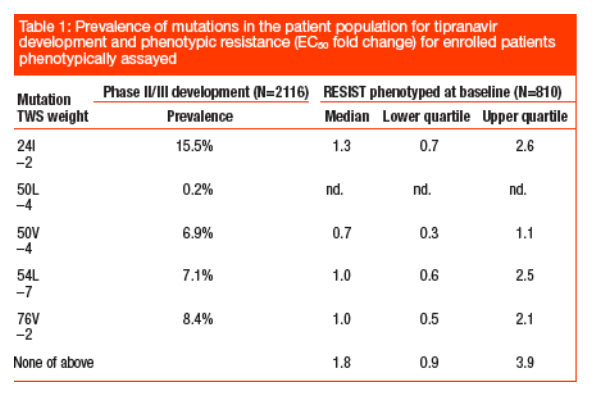
At Week 8 response rates differed by at least 14% higher for those with any of
the mutations (minimum 59.1%) when compared to those with none (44.6%)
(Table 2).
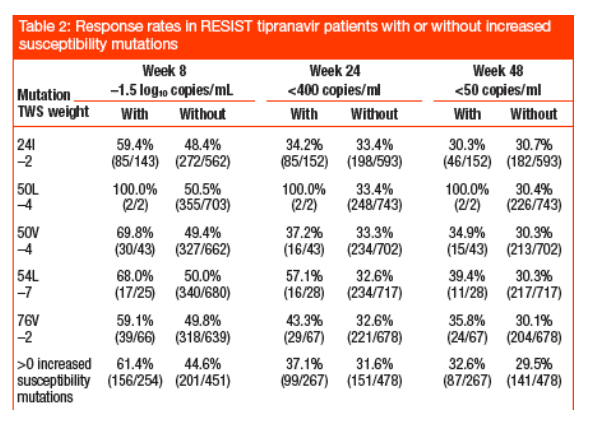
· At all three timepoints the effect of increased susceptibility mutations on response rates was apparent in patients with little or no support from the background regimen (Table 3).
· At all three timepoints the effect of 2 or more increased susceptibility mutations on response rates was apparent in patients with support from the background regimen (Table 4).
· The effect of 1 increased susceptibility mutation was not sustained through 48 weeks in patients with BAS >0.5 (Table 4).
· The effect of 2 or more mutations was significant with adjustment for background regimen at all three timepoints, Mantel-Haenszel p-values (Table 4).
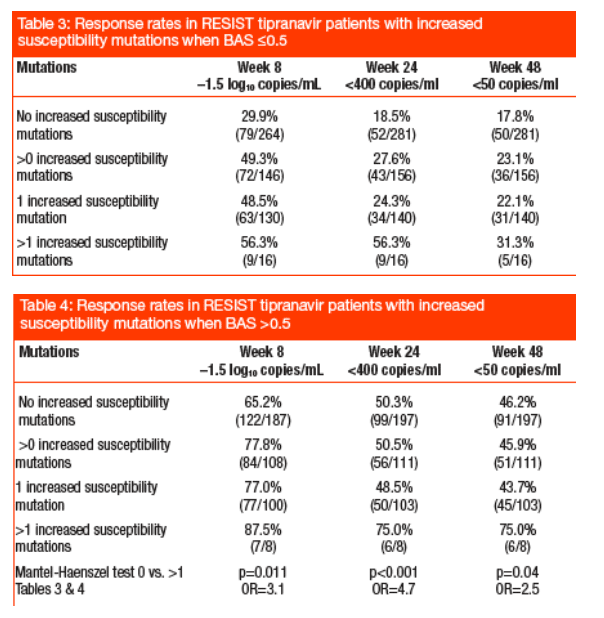
The TPV weighted score was lower for patients using amprenavir, nelfinavir or
saquinavir in a failing regimen than for patients using atazanavir, indinavir, or
lopinavir in a failing regimen (Figure 1).
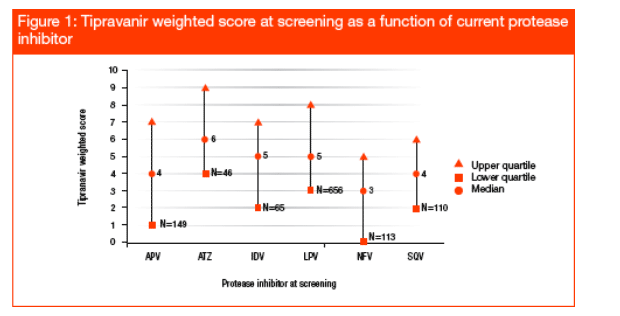
Amprenavir was associated with the highest prevalence of mutations increasing susceptibility to TPV (Figure 2)
Nelfinavir had the lowest prevalence of mutations increasing susceptibility to TPV (Figure 2).
24I was seen in over 10% of patients, regardless of protease inhibitor (Figure 3).
50L was seen only in atazanavir patients (Figure 3).
50V was seen with all the protease inhibitors except atazanavir (Figure 3).
54L was strongly associated with amprenavir (Figure 3).
76V was associated with amprenavir and lopinavir (Figure 3).
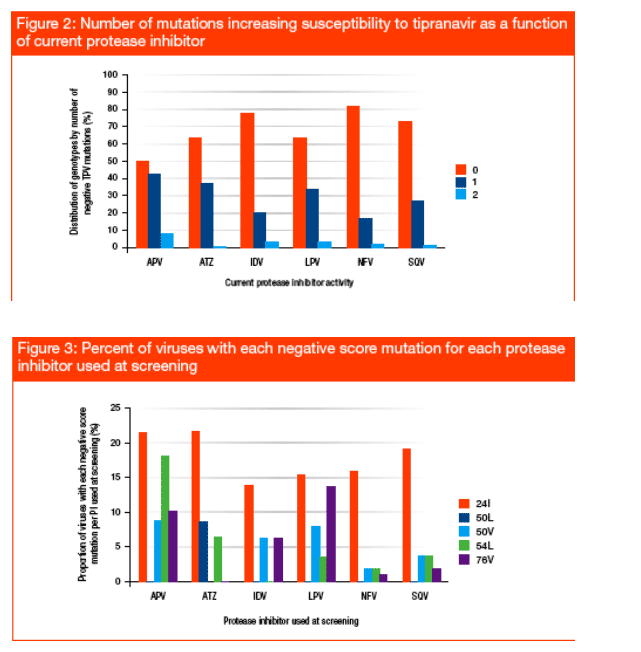
Response at 8 weeks was significantly associated with the BAS and the Positive Mutations of the Weighted Tipranavir Score (TWPS) (Figure 4).
Having at least one mutation increasing susceptibility to tipranavir more than doubled the odds of responding, OR 2.354 (p<0.001) (Figure 4).
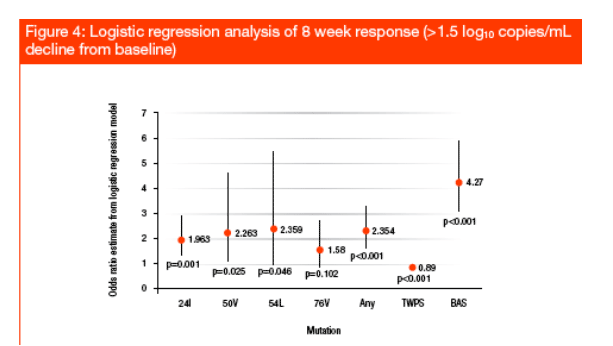
TWPS = the part of the Tipranavir Weighted Score that is based on mutations that decrease susceptibility, the sum of the positive weights.
Response at 48 weeks was significantly associated with the BAS and the Positive Mutations of the Weighted Tipranavir Score (TWPS) (Figure 5).
Having at least one mutation increasing susceptibility to tipranavir was of diminished effect, but still significantly increased the odds of responding, OR 1.467 (p=0.045) (Figure 5).
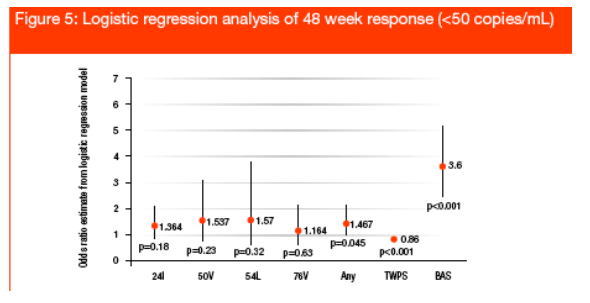
REFERENCES
1. Parkin N, Chappey C. Protease mutations associated with higher or lower than expected tipranavir susceptibility based on the TPV mutation score. 13th CROI, 5-8 February 2006, Denver, CO. Poster 637.
2. Van Craenenbroeck E, Vermeinren H, Muyldermans G, Van der Borght K, Alen P, Bacheler L, Lecocq P. Prediction of HIV-1 drug susceptibility phenotype from viral genotype using linear regression modeling. 4th European HIV Drug Resistance Workshop 29 - 31 March, 2006, Monte Carlo, Monaco (Poster # 60).
3. Scherer J, Boucher CA, Baxter JD, Schapiro JM, Kohlbrenner VM, Hall DB. Improving the prediction of virologic response to tipranavir: the development of a tipranavir weighted mutation score. 6th European HIV Drug Resistance Workshop 26 - 28 March, 2008, Budapest, Hungary (Poster # 94).
4. Hall DB, Baxter JD, Schapiro JM, Boucher CAB, Piliero P, Scherer J. Linear modeling to estimate the contribution of each drug component of the regimens of highly treatment-experienced patients in RESIST. 11th European AIDS Conference/ EACS, October 24 - 27 2007, Madrid, Spain (Poster # P3.4/22)
|
| |
|
 |
 |
|
|